China Beijing Opera
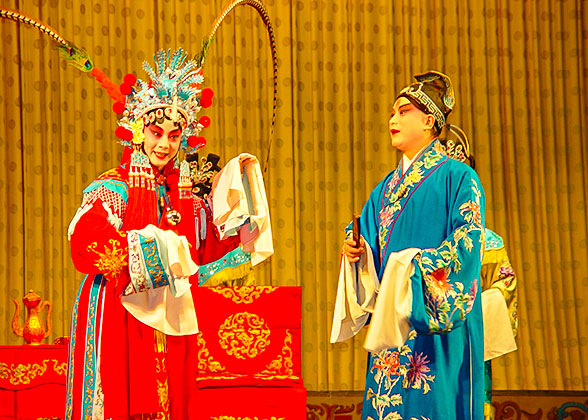 |
Beijing Opera is developed from absorbing many other dramatic forms, mostly from the local drama 'Huiban' which was popular in South China during the 18th century. It is a scenic art integrating music, performance, literature, aria, and face-painting. Certain rules are set up and regulations are standardized during many artists' long practice on stage. Different from regional plays, it is stricter on the variety of the workmanship. The combination of virtual and reality - a special technique of expression, keeps it largely free from the restriction of time and space on stage performance. Beijing Opera has had many interesting names since it came into being, such as Jinghuang, Daxi, Pingju, Jingxi.
Four Means of Artistic Presentation
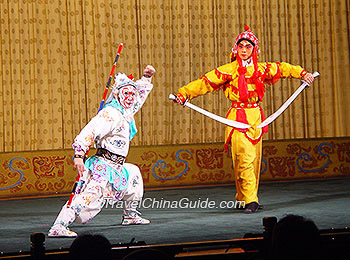 Beijing Opera presents dramatic plays and figures mainly by infusing four artistic methods: singing, dialogue, dancing and martial art. Singing is utilized to intensify the appeal of the art by all kinds of tones. Dialogue is the complement of singing which is full of musical and rhythm sensation. Dancing refers to the body movements requiring high performing skills. Martial art is the combination and transformation of traditional Chinese combat exercises with dances.
Beijing Opera presents dramatic plays and figures mainly by infusing four artistic methods: singing, dialogue, dancing and martial art. Singing is utilized to intensify the appeal of the art by all kinds of tones. Dialogue is the complement of singing which is full of musical and rhythm sensation. Dancing refers to the body movements requiring high performing skills. Martial art is the combination and transformation of traditional Chinese combat exercises with dances.Main Roles in Beijing Opera Performance
Sheng:
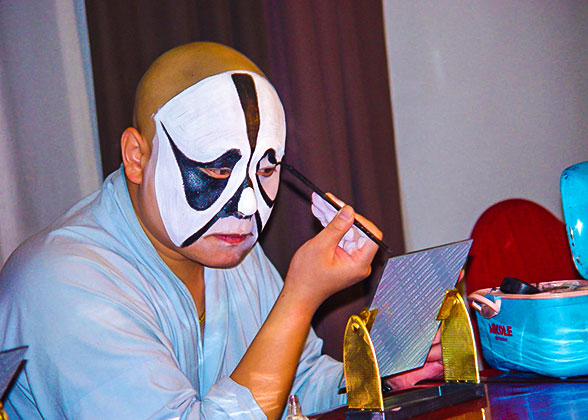
Dan:
Jing:
Facial Painting (Lianpu)
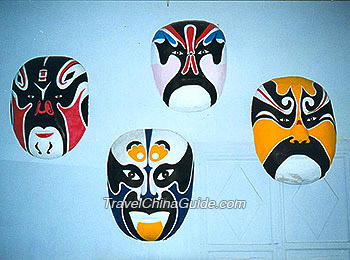 |
| Facial painting in Beijing Opera |
Colors of Lianpu are varied with each representing a characteristic. For example, red symbolizes loyalty, such as Guanyu, a great general during Three Kingdoms Period (220-280). Black signifies honesty and frankness, such as Lord Bao, a righteous official during Northern Song Dynasty (960-1127), or abruptness and impertinence, such as Likui, an important figure in the famous Chinese ancient novel 'All Men Are Brothers'. White stands for cattiness and cunning, with Caocao as its representative, a famous politician in the late Eastern Han Dynasty (25-220).
Stage Properties (Qimo)
Four Famous Artists
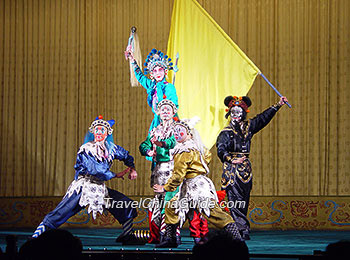 There are many famous masters who are good at performing Beijing Opera. Among them, the Four Famous Dans - Mei Lanfang, Cheng Yanqiu, Shang Xiaoyun and Xun Huisheng - are most well-known at home and abroad. They are experts in performing the role of Dan and each has his own artistic feature. Their wonderful performances are still appreciated by many audiences. For example, 'Farewell My Concubine' by Mei Lanfang, 'Injustice to Dou'e' by Cheng Yanqiu, 'Lady Zhaojun Going beyond the Great Wall' by Shang Xiaoyun and 'Matchmaker' by Xun Huisheng.
There are many famous masters who are good at performing Beijing Opera. Among them, the Four Famous Dans - Mei Lanfang, Cheng Yanqiu, Shang Xiaoyun and Xun Huisheng - are most well-known at home and abroad. They are experts in performing the role of Dan and each has his own artistic feature. Their wonderful performances are still appreciated by many audiences. For example, 'Farewell My Concubine' by Mei Lanfang, 'Injustice to Dou'e' by Cheng Yanqiu, 'Lady Zhaojun Going beyond the Great Wall' by Shang Xiaoyun and 'Matchmaker' by Xun Huisheng.Beijing Opera contains the soul of Chinese national culture. Its unique charm inspires ethos of Chinese people. There is no doubt that it is really the treasure of Chinese culture. If you want to taste the real Beijing Opera, Liyuan Theatre in Beijing will be a good choice for you.![]() Related Reading: Beijing Opera Theaters, Beijing Travel Guide
Related Reading: Beijing Opera Theaters, Beijing Travel Guide
- Last updated on Jul. 30, 2024 by Brenda Lian -
Questions & Answers on China Beijing Opera
Asked by JJ from CANADA | Jul. 29, 2024 14:20 Reply
Reply
Do the operas only tell historical stories, or are these sometimes folk stories as well?
Answers (2)
Answered by Keith | Jul. 30, 2024 01:40 0
0 0
0 Reply
Reply
Beijing Opera has folk stories as well.
Answered by Ail | Sep. 25, 2024 06:36 0
0 1
1 Reply
Reply
Most of the Chinese operas tell both of them
Asked by Muhammad from PAKISTAN | Jan. 04, 2023 10:13 Reply
Reply
do chinese use martial arts in their dancing performance
Answers (1)
Answered by Rubin | Jan. 09, 2023 22:15 0
0 0
0 Reply
Reply
Yes. In Beijing, you can go to Red Theater to see the show involving martial arts movements.
Asked by Katie from UNITED STATES | Mar. 12, 2019 08:19 Reply
Reply
What are the characters in simplified Chinese for huiban?
Answers (1)
Answered by Daisy from NEW ZEALAND | Mar. 12, 2019 19:48 0
0 0
0 Reply
Reply
The Chinese should be 徽班.
Asked by Brayver from PHILIPPINES | Jan. 10, 2019 00:35 Reply
Reply
Similarity about peking opera and kabuki
What was the similarities of peking opera and kabuki? I've got curious from it
Hope someones aswer my question.
I need it tomorrow or later for our project
Thank you :")
Hope someones aswer my question.
I need it tomorrow or later for our project
Thank you :")
Answers (3)
Answered by Diana from MALAYSIA | Jan. 10, 2019 21:40 0
0 0
0 Reply
Reply
The similarities are as follow:
1.The structure and the expressions, they all combine the traditional elements like poems and folk legends.
2. They are all very popular in common people and it is rooted in popular culture.
3. The music elements play a very important role in both.
1.The structure and the expressions, they all combine the traditional elements like poems and folk legends.
2. They are all very popular in common people and it is rooted in popular culture.
3. The music elements play a very important role in both.
Answered by Brayver from PHILIPPINES | Jan. 11, 2019 00:59 0
0 0
0 Reply
Reply
Thank you!! This helps me a lot!!❤
Answered by Flora Wang | Apr. 15, 2021 15:49 0
0 0
0 Reply
Reply
Besides, each place in China has its own folk opera, with similar stories while the dialects and the tunes
are different. It started in ancient time as community play, farmers entertain themselves by inviting the folk opera band to play in celebration of the harvest season.
are different. It started in ancient time as community play, farmers entertain themselves by inviting the folk opera band to play in celebration of the harvest season.
Asked by Lila from USA | Nov. 06, 2018 11:04 Reply
Reply
Confused
The article says the Chinese opera started about 160 years ago, but I read another article saying it began in 1790. Even if you subtract the date this article was published you get an answer no where near 1790. Which is right?
Answers (1)
Answered by Anne from NEW ZEALAND | Nov. 06, 2018 19:12 0
0 0
0 Reply
Reply
Hi, the Hui Opera started from the 1790 and it was the predecessor of the Beijing Opera. After several decades, the formal Beijing Opera gradually formed around 1850 and that's why the article says it stared about 160 years ago.